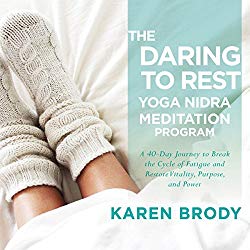
The Daring to Rest Yoga Nidra Meditation Program: A 40-Day Journey to Break the Cycle of Fatigue and Restore Vitality, Purpose, and Power, by Karen Brody
Sounds True, 9781683640691, 2018
“Be comfortable, listen to the voice guiding you and do nothing” are the simple instructions that Karen Brody gives in the introduction to The Daring to Rest Yoga Nidra a Program: A 40-Day Journey to Break the Cycle of Fatigue and Restore Vitality, Purpose, and Power, and when I heard them I thought “I can do that.”
I am a survivor of early childhood abuse, and live with compounded PTSD. On top of my long-term stress, I have been feeling anxious about winter and the wild fluctuations of severe weather. Hearing the invitation to find comfort and doing nothing appealed to me deeply.
After accessing the “Daring To Rest” meditation, I literally got comfortable on the couch, listened to Karen Brody’s calm narration, and took notes. Initially, I took notes so I could make specific recommendations regarding the Daring to Rest program for this review.
With a wonderful introduction centred upon her own experience overcoming a family legacy of panic attacks and getting off of anti-anxiety medication, Brody introduces Daring to Rest and its origins in her own therapeutic yoga nidra practice. I like literature generated by people who have lived an experience and sought ways to remedy it, and Daring to Rest is a wonderful combination of Brody’s experiences, insights and the results of her formal research.
Described as “yogic sleep” or “conscious relaxation,” yoga nidra includes a series of body scanning, breath work and visualization exercises which teach us how to go into a deep state of non-doing. Non-doing really appealed to me.
The 40-day Daring to Rest program is organized into three phases: rest, release, and rise. It is designed to actually teach us how to do each of these and structured to help the listener slow down, let go of worries and stress, and then come back to consciousness feeling relaxed and calm. The structure of each day’s yoga nida practice is a microcosm of the overarching structure of the 40-day program.
I knew right away that this program was something I had been searching for. With adrenal fatigue and anxiety issues being the primary symptoms of my complex PTSD, I had been attempting to remedy exhaustion in my life. I appreciated Brody’s integrated approach to healing, recognizing that stress was often a cluster of symptoms which spread across multiple areas of life.
With roots in the yogic tradition, Daring to Rest includes eight meditations which are used for five days each. They address the physical body; the energy body; the emotional body; meeting your darkness and clearing the mental body; cleaning the wisdom body; cleaning the bliss body; rising up, finding your gold, your voice; and yoga nidra for life, “daring to rest forever.”
Before diving into the 40-day program, participants are asked to set intentions. Using deep breathing to slow down, we listen to our own “soul whispers” for each of the 40 days and record them. A soul whisper is described as a signal from your soul that moves you forward in your life. I experienced the soul whispers as a voice literally speaking to me. As I came out of yoga nidra meditation, I heard whispers like “I feel supported by Carolin,” “I am soooo relaxed and grounded,” and “I feel safe with Georgia.” These soul whispers enabled me to recognize people, places and practices existing in my life that supported soul nurturing and nourishing.
Brody recommends engaging in free writing after practicing yoga nidra, not just to jot down the soul whispers, but also to clear the slate. As an adherent of The Artist’s Way by Julia Cameron, I have been writing morning pages for years. Morning pages are also a free writing practice — you simply start writing and don’t stop for three minutes or three pages. I find the practice helps me to hear what is going on inside, to get to the heart of a matter or discover what is bothering me, and to clear my head of clutter.
Daring to Rest also introduced me to another practice that I have used, though not in such a conscious and regular manner, the practice of carrying a “touchstone.” A touchstone is a small object like a stone or crystal that can be held in the left hand, the receiving side. A touchstone helps to consciously connect or reconnect you to calm, peace and tranquility.
A key step in the Daring to Rest program is setting an intention — making a vow or promise to your highest truth. The intention is meant to “come from the heart and support your total well being.” It points you back toward wholeness. I appreciated the inference that my deepest instinct was to return to wholeness, and that my deep healing would ultimately come from deep within me.
During meditations I was asked to repeat my intention at the beginning, in the middle, and at the end. Apparently making the intention during a deep yoga nidra meditation enables us to absorb it into our deepest subconscious, and act upon it. Your intentions can come from your soul whispers, stated in the present moment, and in the positive. I generalized the soul whispers I had been hearing to form my intention, saying “I am surrounded by support, healing, and safety.”
While it initially felt like a daunting commitment to take on a 40-day program, and I admit that there were stops and starts and restarts in there, I have found great benefit from building a regular practice of conscious rest, release and rising. Building on my meditation and writing practices, Daring to Rest focused and augmented what I had already been doing. I found physical relief in the yoga nidra practice, and over time noticed a reduction in my residual stress and exhaustion, and eventually became aware of a lessening of my arousal or fight or flight instincts.
The research being done around trauma informed yoga insists that there is no way to fight stress, and that learning peace is the only real antidote to trauma and PTSD. The regular practice of Daring to Rest has enabled me to learn new methods for cultivating peace, and has brought sustained and deep reaching therapeutic effects in my physical, emotional and mental health. While I am still uncertain about my “wisdom body,” I have had a few soul whispers that have put me in touch with the fact that I contain specific wisdom distilled from my experiences. Perhaps my wisdom body is healing.
As for the “bliss body,” I can’t attest to any noticeable improvement, but I trust that experiencing the effects of rest and release will eventually enable me to rise.
Image Credit: Zo Jimney Photos









